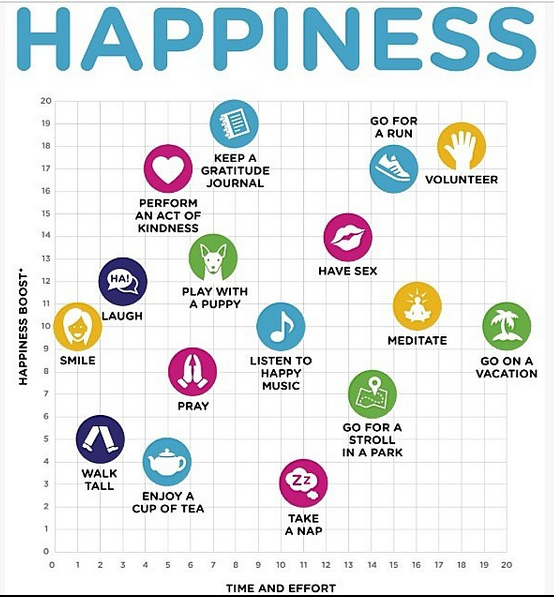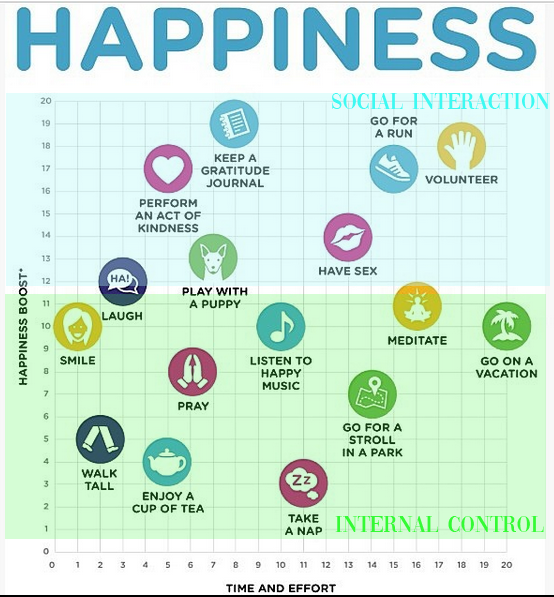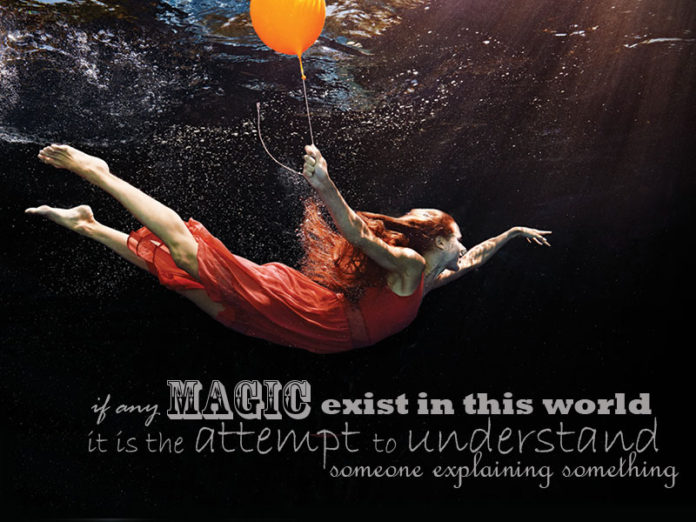INTRODUCTION
“NATURE HAS PLACED MANKIND UNDER THE GOVERNANCE OF TWO SOVEREIGN MASTERS, PAIN AND PLEASURE. IT IS FOR THEM ALONE TO POINT OUT WHAT WE OUGHT TO DO, AS WELL AS TO DETERMINE WHAT WE SHALL DO.” – JEREMY BENTHAM (1748-1832)
In this way, he claims that attaining pleasure (happiness) and avoiding pain (unhappiness) are the ultimate objectives of everything we do.
There are so many ways to find happiness, many streams leading to that blue ocean. Happiness is found in sleeping late, reading, sex, cuddling, recharge of the soul, visiting a zoo, museum, theater, clutter-busting, gardening, social work, helping neighbors, beautifying the home, thinking, praying, meditating, and yoga, to name a few.

A haphazard search for happiness leads to unpredictable and unsustainable results. Learning how to get happiness, the methods are mostly not formally taught, but we need to learn this life essential. I have taken a stab to create some broad predictable, digestible tributaries that hopefully can help others find their path to their greatest swim in that ocean of happiness.
Where you live can make the biggest impact on your happiness. There are food, shelter, education, and satisfying work. The work becomes more enjoyable if you have a best friend at work and feel like you are truly helping others.
“HAPPY FAMILIES ARE ALL ALIKE; EVERY UNHAPPY FAMILY IS UNHAPPY IN ITS OWN WAY.” –TOLSTOY
If we follow Tolstoy’s sentiments, it will make sense to share my thoughts in light that there might be a commonality between our lives.
Notwithstanding that, luck and mindset create the zone for happiness. I have recently realized that there are 2 main ways I have experienced happiness. The first way is in the present moment, what I shall refer to as the experiencing self. The second is the reflective self, in which case remembering the good times allows me to relive the moments repeatedly and experience the emotion just as I did when it first happened.
Experiencing Self
The experiencing self we will break into 3 categories (and each will become a part of this series)
- Social Interaction: the bulk of social interaction is family and friends but not excluding interaction on the job. This is not to be mistaken for being an extrovert. It does not matter if you are an introvert or an extrovert; this interaction makes you feel the kind of love you want in your life. It might be romantic love, but it could also be a deep friendship or a general sense of support and connection.
- Internal Control and Personal Mastery: Autonomy—the desire to direct our own lives; Mastery—the urge to get better and better at something that matters.
- Money and Job: what we are paid, what is the purpose of the work, and what we achieve toward that purpose—the yearning to do what we do in the service of something larger than ourselves.
Reflecting Self
- Exploring and/or Reflecting: We are born to explore, experience, learn, and grow. When we reflect on these experiences, we can enjoy the happiness in the same manner that we did “at the moment” it happened. Therefore, many people cherish photographs, albums, and personal videos.
Let us go over the experiencing self in more detail.

SOCIAL INTERACTION – PART 1
Family relations and personal life make 85% contributions to happiness. That is, points 1, and 2 above make up the Pareto of our happiness. 85% of happiness in my life comes from spending time with people I love, and 15% comes from work achievement, quality at work, and quantity of time with professionals at the job. Socialization and intimacy contribute substantially to most of my memories of peak moments of happiness. Happiness is amplified when shared.
7 THINGS TO IMPROVE SOCIAL INTERACTION
Seek to understand others before trying to be understood. I will borrow 3 of the 13 virtues from Benjamin Franklin and add 4 more to assist to that end.
Cheerful: people love to see and support “nice” people, but nice is really defined as a cheerful person that makes others feel important.
Silence. Speak not but what may benefit others or yourself; avoid trifling conversation.
Sincerity. Use no hurtful deceit; think innocently and justly, and, if you speak, speak accordingly.
Humility. Imitate Jesus and Socrates. Avoid phrases like “you always or you never,” get rid of pride words like “absolutely, surely, always, never” but instead use “I concede, I understand, I apprehend, I can imagine, I can see in this case you are right.”
Compassion is the key to happiness in relationships. Living a principle-based life is the only way to happiness, not efficiency of the clock or accuracy of your facts but the compass of the heart. Avoid the need to be right. It is better to be kind than to be right.
Attention is an important factor for a happy relationship. Small positive attention is the little things that make the big difference. For example, just remembering someone’s name or birthday shows you are paying attention in a big way.
Social: Most of all, you must socialize to practice all the above. I have written a specific article for beginner dancers to socialize in the salsa community, where there is a significant rejection per hour. If you ask a new partner to dance a song every 3 minutes, then in 60 minutes, you will have to ask for 20 dances. That is 20 possibilities of rejection. The same approach to overcome the fear of rejection can work in a conference or enterprise company meeting where there is no obligation to interact and get rejected.
in part 2, I will dive into the aspect of Internal Control and Personal Mastery
in part 3, I will dive into the aspect of Money and Job
YOU WILL FIND MEANING AND HAPPINESS WHEN YOU CAN FIND BEAUTY IN A FLOATING FISH HEAD IN A BOWL OF DIRTY WATER. – Wayne Dyer, in his book, Secrets of Manifesting
Stephen Choo Quan
Thanks for reading and Sharing ❤
Follow me On: Instagram | Facebook | Linked in
Subscribe for Monthly Inspiration












[…] if you have not read part 1 […]
Comments are closed.